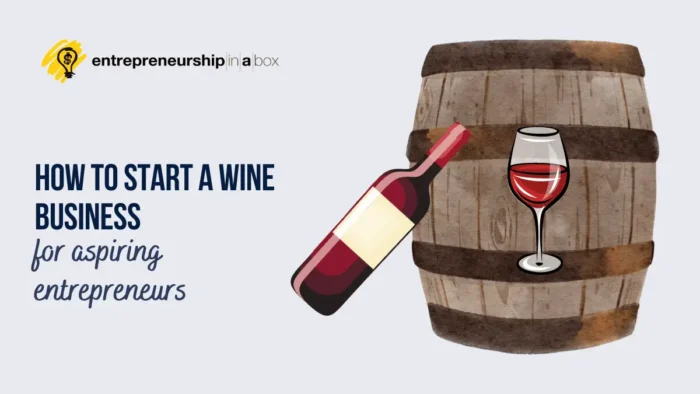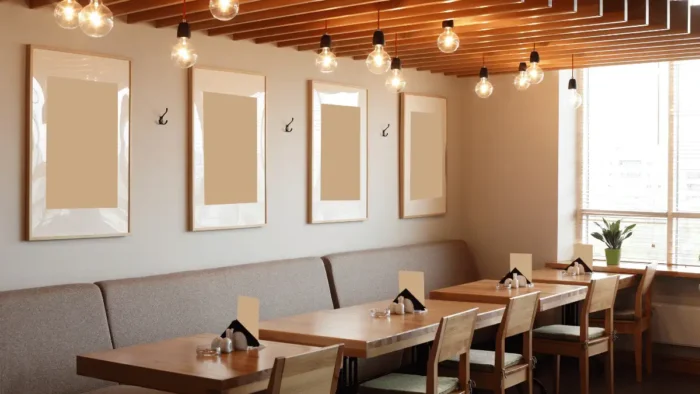Are you wondering how to start a winery? This guide offers the practical steps necessary to take you from wine lover to winery owner. We will cover essentials like crafting the right business plan, securing your vineyard, and understanding legal requirements.
We’ve refined the process into an approachable sequence, setting you up for a successful venture in the competitive world of winemaking.
Key Takeaways
- Developing a detailed business plan with a vision and mission statement, market research, financial planning, and risk analysis is crucial for the success and financing of a new winery.
- Selecting the right location and understanding the complexities of grape cultivation and the production of wine are essential factors in establishing a successful winery.
- Managing the legal landscape of this industry – including business entity formation, compliance with laws and taxes related to alcohol, and acquiring the appropriate licenses – is imperative to operate a winery.
Develop Your Winery Business Plan

Starting a successful winery must begin with a concrete business plan that will help you manage all important things related to the startup process. This document is more than just a roadmap; it’s your blueprint for success. The business plan provides direction and increases the likelihood of securing financing.
An extensive winery business plan includes different key components, including:
- A vision and mission statement
- Market research
- Financial planning
- Risk analysis
All of these components contribute towards establishing your own wine brand among various wine brands on the market.
Related: 9 Steps to Start a Charity
Vision and Mission Statement
The heart and soul of your winery business plan are your vision and mission statements. These statements define your winery business direction and effectively communicate your brand values to your customer base, influencing their choice of drinking wine.
Your vision and mission statements should outline the purpose of your winery’s daily activities, define your target audience, and outline your primary products and services, guiding you in formulating strategies to sell wine.
Related: 30 Mission Statement Examples to Kickstart Your Business Journey + Templates
Market Analysis and Strategy
Understanding the wine business environment is one of the most important things to the success of your winery. An extensive market analysis assists you in identifying your target customers and developing a strategy to engage with them. This includes:
- Research the wine industry. If you want to start your own wine business, you must conduct extensive research on the industry to learn more before everything else. You can use the following 42 questions to guide you through industry analysis.
- Identify the main competitors. You must be prepared and know that your wine business will always have competition. So, analyze the most important wine businesses that will be your competitors. These 22 competitive analysis questions will help you beat your competitors.
- Analyze their offerings. What they are offering and how they are offering what they offer. You must carefully review all their offers and learn as much as possible about them to build a strong wine brand. Remember that you want to find the gap in the market and ensure your total offer will be better and more competitive.
- Differentiate your winery’s offerings from theirs. You must develop a superior value proposition for your wine brand. You must ask and respond to these four questions about your total offer, but from the customer’s perspective.
Your research should also assess the market need and help you prepare a strategy for how your winery will address that need.
Related: 4 Steps Business Idea Generation Process in Entrepreneurship
Financial Planning
Building a winery requires a considerable financial commitment. The initial investment typically ranges from $600,000 to the low millions, covering substantial expenses such as vineyards (if you want to produce your own grape), equipment, licensing, insurance, and permits. A study at Washington State University indicated that the minimum cost for a 2,000-case winery was around $560,000. For a larger operation, a 20,000-case winery required over $2 million in initial investments.
Remember that everything will depend on how large your business will be. For example, you can start a small winery as a possibility for aspiring vintners who aren’t ready to buy land in Napa Valley, one of the world’s best wine regions, and save something on serious capital you want to invest.
First, you must list your startup costs, like purchasing equipment, inventory, permits, operating expenses, and other startup costs. So, this will respond to how much money you will need to open your company’s door.
After you determine your start-up costs, it’s crucial to start developing financial projections. This should include revenue forecasts based on your planned production volume, price per bottle, and projected operating expenses. It’s also wise to factor in a contingency budget for unexpected costs. A realistic projection might show that the business will not generate profit until the second or third year.
The next thing is your pricing strategy. You must consider the production cost, market demand, and competitor pricing. If your cost of production per bottle is $5 and competitors sell similar wine for $15, you might consider a price of $20 if your wine offers superior quality or a unique selling proposition. Remember, your price should cover your costs and desired profit margin and reflect the value customers perceive in your product.
A comprehensive financial plan is significant for your winery’s sustained success. This plan will help you track all expenses and manage your small business operations effectively.
Risk Analysis
Like any other small business, a winery comes with its own risks. A detailed risk analysis is integral to your business plan, helping you identify potential threats and develop coping strategies. By implementing measures for overcoming or reducing possible risks, you can ensure your winery thrives in the face of challenges and stays ahead in the competitive wine market.
You can follow this risk management guide to help you conduct appropriate risk analysis and prepare a mitigation plan.
Related: Everything You Need to Know About Financial Risk
Vineyard Selection and Wine Production Essentials
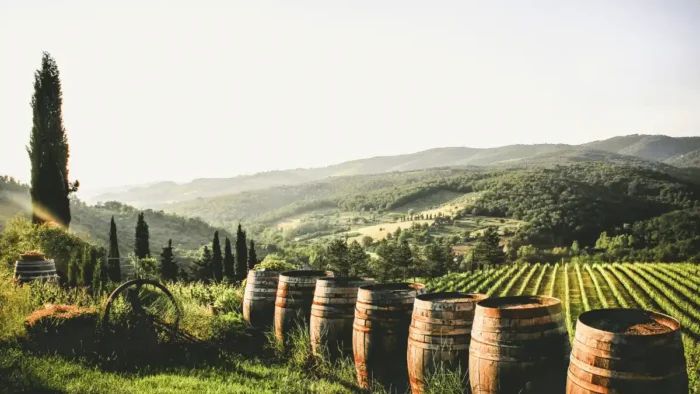
With your business plan developed, you can proceed to the practicalities of initiating a winery – choosing a vineyard and producing wine. Selecting an ideal location for your vineyard and perfecting grape cultivation are vital steps toward the success of your winery.
Choosing the Perfect Winery Location
The perfect location for your winery will depend on several factors, including:
- Climate suitability for grape cultivation
- Soil composition
- Land’s suitability for growing specific grape types
- Accessibility for visitors, staff, and distribution logistics
The Art of Growing Grapes
Growing wine grapes is an art that requires knowledge and patience. Understanding the different grape sorts and their cultivation requirements is key to producing high-quality grapes. You must also closely monitor the soil and climate conditions and employ effective pruning techniques to manage your grape vines.
The Winemaking Process
In the winemaking process, the cellar plays a critical role. It’s where the transformation from grape to wine happens and where the wine produced is stored to mature. To facilitate this, several pieces of equipment are essential in making wine:
- Fermentation Tanks. Fermentation tanks are where the magic begins. They’re used to ferment the grape juice into wine.
- Crushers and Destemmers. Before fermentation can begin, grapes need to be crushed to extract the juice and separated from their stems. Crushers and destemmers are machines that perform these tasks efficiently, saving time and labor.
- Presses. After fermentation, the wine needs to be separated from the remaining grape skins and seeds. Presses apply pressure to the fermented grapes (pomace), extracting the wine while leaving behind the solid matter.
- Storage Barrels. Once the wine has been pressed, it’s often transferred to barrels for aging. The type of barrel used can significantly affect the wine’s flavor, with oak barrels often used to impart additional complexity and tannin structure.
- Bottling Line. When the wine has matured to the winemaker’s satisfaction, it’s time for bottling. A bottling line typically includes equipment for filling bottles, corking or capping them, applying labels, and sealing the top with foil or wax.
- Pumps. Pumps are used throughout the winemaking process, from transferring grape must to the fermentation tanks, moving wine between tanks and barrels, and pumping the finished wine into the bottling line6.
- Temperature Control Systems. Temperature plays a critical role in both fermentation and aging processes. Therefore, wineries often invest in temperature control systems to maintain optimal conditions in their cellars.
The cellar equipment for wineries is designed to facilitate each step of the winemaking process, ensuring that the transformation from grape to wine is efficient, controlled, and consistent.
Legalities and Regulations in the Wine Industry

In the world of winery businesses, compliance with legalities and regulations is as important as the taste of your wine. It’s required for your winery to form a business entity, comply with alcohol laws and taxes, and secure necessary licenses and permits.
Establish Your Entity With the Right Legal Structure
Starting a winery involves choosing a proper legal structure that will protect your personal assets and establish the legal structure of your winery. This can be a corporation, a limited liability company (LLC), or a sole proprietorship, each with its own advantages and disadvantages, and you can find more about the right legal structure here.
Complying with Alcohol Laws and Taxes
As a winery owner, you must comply with the following regulations:
- Federal license: Your first stop will be the Alcohol and Tobacco Tax and Trade Bureau (TTB) to obtain a federal license for beverage alcohol. This permit allows you to operate in the wine industry and is a prerequisite for most other licenses and permits to produce and sell alcohol.
- State licenses and permits: Most states require wineries to apply for additional licenses and permits. These requirements vary based on the state, and some states may also require that you have a winery permit, like through the State Liquor Authority (SLA) in New York State.
- Excise tax license: Some states, such as Alaska, require licensees to obtain an excise and sales taxes license, which requires a $25,000 tax bond. In addition to the Excise Tax License, most states require wineries to apply for sales tax applications. The TTB also provides forms for tax determination on wine.
- Wine shipper permit: If you plan to ship your wine directly to consumers, you’ll need a Wine Shipper Permit. The forms needed include a Business License Application and a Non-retail WSLCB Addendum.
Remember that non-compliance can lead to substantial fines and penalties.
How You Will Finance Your Wine Business

If you’re looking to start a winery, it’s essential to understand that it is a significant financial undertaking. Regardless of whether the venture is self-financed or relies on external funding, it’s crucial to maintain a strong financial foundation, investigate different loan and credit possibilities, and consider innovative financing options.
Build a Strong Financial Foundation
Building a strong financial foundation involves a combination of personal savings, a high personal credit score, and a solid business plan. These elements can significantly improve your chances of securing the necessary funding for your wine business.
Explore Loan Programs and Credit Options
Several loan and credit options are available to help finance your winery. These include:
- Bank loan. Traditional banks also offer loans, but these usually require a strong credit history, a solid business plan, and, in many cases, collateral. Interest rates can vary, and the approval process can be rigorous.
- Equipment loans. The equipment loan can be a good option for those purchasing expensive wine-making equipment. The equipment itself serves as collateral, making this type of financing easier to obtain. The downside is that the lender can seize the equipment if you fail to pay.
- Business lines of credit. A business line of credit is a flexible financing tool that can help manage short-term expenses like payroll, inventory, and even unexpected costs. Unlike traditional loans that provide a lump sum of money, a business line of credit allows businesses to borrow up to a certain limit and only pay the interest on the amount used. For example, U.S Bank offers several business line of credit options to help you manage cash flow.
- Business credit cards. A business credit card can be an excellent tool for managing cash flow and covering smaller, ongoing expenses. They also offer the advantage of rewards programs. However, they should be used responsibly because you must pay interest, which can lead to costly debt if balances aren’t paid off each month.
Each option has its own advantages and disadvantages.
Creative Funding Solutions
Consider creative funding solutions if traditional financing options don’t fit your winery. Crowdfunding, private investors, or partnerships can provide the necessary capital to make your dream a reality.
- Crowdfunding. Platforms like Kickstarter and GoFundMe allow businesses to raise funds from many people, typically in exchange for product samples or experiences. This can be a great way to engage your target audience as a future customer in your winery’s story.
- Venture capital and angel investors. Venture capital firms and angel investors provide funding in exchange for equity in the company. This option could be viable if your wine business has high growth potential.
- Partnerships. Partnerships can also be a creative and effective way to secure funding for your wine business. Such partnerships offer many different benefits, including shared risk, pooled resources, and the potential for unique marketing opportunities. For example, you can find vineyard owners to become your partners, so you will not need to invest in vineyards and ensure a continuous flow of grape supplies for wine manufacturing.
Related: 13 Failproof Ways to Raise Money Fast for Your Startup
Branding and Marketing Your Wine Business
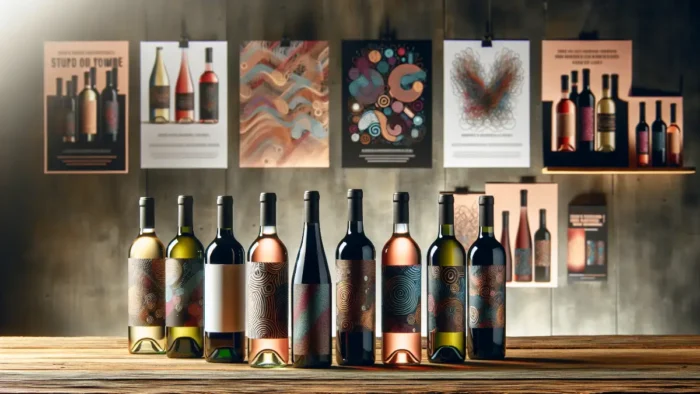
With the operational elements of your winery established, the focus must change to branding and marketing. Building a strong brand and implementing an effective marketing plan are essential for attracting customers and making your wine business stand out in the market. So, when you start developing your marketing plan, think about the following things:
Design Memorable Wine Labels
One of the first things customers notice about a wine bottle is its wine labels. Well-designed and memorable wine labels catch the eye and convey your brand’s identity and story. So, you must invest in innovative bottles and memorable wine labels if you want to brand your wine business so it will quickly become recognizable to potential customers.
Tasting Room Experience
Your tasting room is where customers get to experience your brand firsthand. Creating a unique space like a tasting rooms for a tasting experience can help you attract customers and create lasting impressions.
Become a Member of Wine Communities
In a particular wine community, you can find wine professionals and lovers eager to witness the launch of new brands that offer fresh perspectives. This is an effective way to integrate yourself with the community and earn a strong client base.
Digital Marketing Strategies
Given the importance of digital platforms, online marketing is key to engaging a larger audience.
Considering that the wine businesses are losing the younger population as wine lovers, according to Silicon Valley Bank’s State of the Wine Industry Report for 2023, it is imperative to use digital marketing strategies, especially platforms where the younger people are.
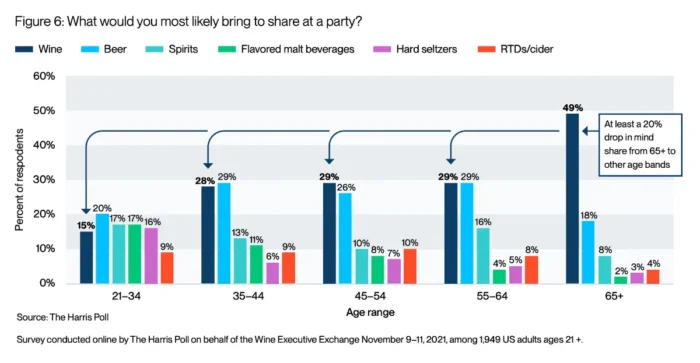
Effective digital marketing strategies for wineries include social media, email marketing, content marketing, and search engine optimization.
- Social Media Marketing. Social media platforms like Instagram, Facebook, TikTok, and Twitter provide an excellent opportunity for wine business owners to share their stories, showcase their products, and engage with their audience. Regularly posting high-quality photos and videos of your vineyard, wine-making process, wine tasting, and events can create a visual appeal that attracts followers. For example, Gary Vaynerchuk, a renowned entrepreneur and speaker, used YouTube to build a wine empire. He launched “Wine Library TV,” a vlog where he tasted and reviewed different wines. His charismatic personality and genuine passion for wine helped him gain a large following, significantly increasing the sales of his family’s wine store.

- Email marketing. Email marketing allows you, as a wine business owner, to maintain direct contact with your customers. Regular newsletters can include updates about new releases, upcoming events, special offers, and interesting content about wine.
- Search Engine Optimization (SEO). SEO involves optimizing your website so it ranks higher in search engine results. This can involve keyword research to understand what terms your audience is searching for, optimizing your website’s content and structure, and building high-quality backlinks.
- Content marketing. Creating engaging and informative content can help establish your winery as an authority in the field, attract visitors to your website, and encourage them to stay longer. This could include blog posts about wine pairing, the wine-making process, or the history of your vineyard, as well as videos, infographics, or podcasts.
Operations Management for Your Wine Business
Operations management is critical to managing a successful business in this industry. This involves everything you do behind the scenes to bring your wine into customers’ hands, like staffing, managing and purchasing inventory and supply chain, implementing quality control measures, and delivery.
Staffing
Your team forms the core of your wine business. Hiring skilled and knowledgeable employees, such as winemakers, vineyard managers, and tasting room staff, is crucial for your winery’s success.
Inventory and Supply Chain Management
Effective inventory and supply chain management is vital to prevent stock shortages and uphold product quality. You must buy grape inventory if you don’t have a vineyard. Also, you must keep track of your inventory, oversee the production process, and ensure that your products reach your customers on time.
Quality Control Measures
Quality control is key to producing great wines. Regular testing and inspections can help ensure consistent wine quality and identify potential issues early.
Preparing for Your Wine Business Launch
Having put in the effort, the moment has arrived to unveil your business to the world. Preparing for your wine business launch involves planning a soft opening to test your operations and collect feedback, followed by a grand opening celebration to officially introduce your winery to the public.
Soft Opening Strategies
A soft opening allows you to:
- Test your winery’s operations in a real-world setting before the official launch
- Refine your operations
- Collect feedback
- Prepare your staff for the grand opening
Grand Opening Celebration
A grand opening celebration is a milestone event that generates buzz and attracts a large audience. Planning a memorable grand opening event can help establish your winery’s presence in the market and attract customers, media attention, and potential partners.
Summary
In this blog post, we’ve walked you through every step of starting a winery, from crafting your wine business plan and securing financing to branding your winery and planning your grand opening. Remember, the journey to starting a winery is a marathon, not a sprint. So be patient, stay focused, and enjoy the ride. Here’s to crafting great wines and creating unforgettable experiences!
Frequently Asked Questions
Owning a winery can be profitable, with the average yearly profit ranging between $80-100k, but profitability is influenced by factors such as the winery’s size.
Starting a winery can be a challenging and lengthy process, requiring significant financial investment and patience, as it may take several years to become profitable.
You will need a minimum of 5 acres to start a winery, which can accommodate about 5,500 vines and yield approximately 55,000 bottles of wine per harvest. To sell to the wholesale market, at least 7 acres are needed, but ideally more for economies of scale.
Starting a wine business can cost between $560,000 and over $2 million in initial investments and additional costs such as payroll, shipping, marketing, and insurance.
A business plan is crucial for a winery as it guides the winemaking process and increases the chances of securing financing, ultimately contributing to the winery’s success.

